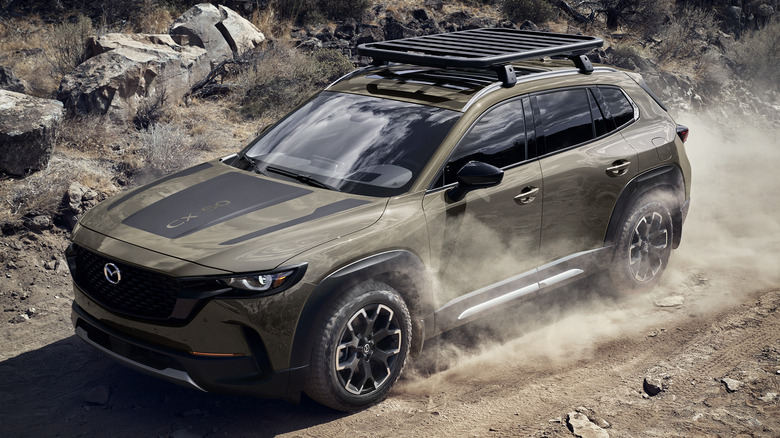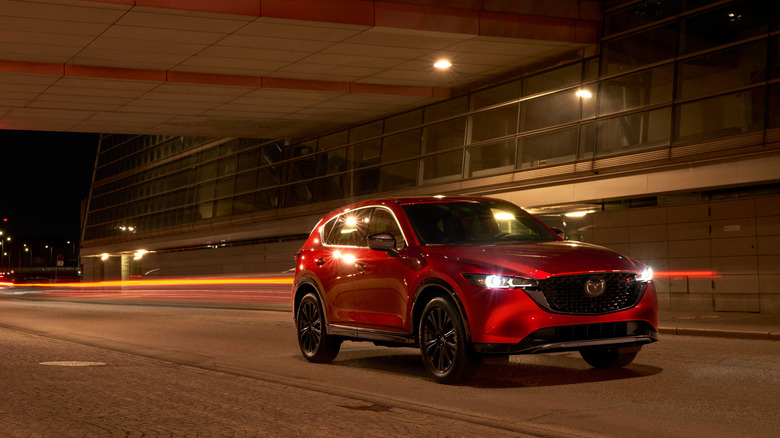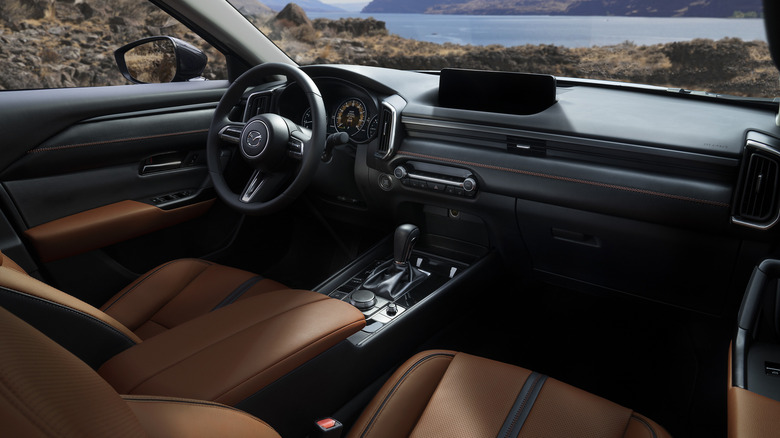Mazda CX-5 Vs. Mazda CX-50: What's Different Between These Compact Crossover SUVs?
Like many automakers these days, Mazda has a significant lineup of SUVs, ranging in size from compact to mid-size three-row crossovers and with several models in between. In fact, of the seven vehicles Mazda currently makes, five of them are SUVs of varying sizes. At the bottom of the range is the compact Mazda CX-30 — a small SUV developed on the Mazda 3 hatchback. Just above the CX-30, though, there's the CX-5 and then the CX-50, which both sit in the lineup below the CX-70 and the three-row CX-90. The trend, as you might have noticed, is that Mazda SUVs get bigger as the numbers go up.
In line with that trend, the CX-50 is slightly larger than the CX-5. The CX-50 is a little bit longer and wider, and it has a bit more room inside. It's also the more rugged of the two SUVs, and even though they ride on different platforms, the CX-50 is essentially a CX-5 scaled for the great outdoors. Both are considered compact SUVs, and there are several similarities between them. Still, they offer a slightly different set of features as well as some unique appeal depending on your needs. But Mazda has recently announced that a new hybrid version of the CX-50 is coming soon, further distinguishing it from the CX-5 — even more of a reason to break down some of their most important stats to help you make up your mind.
Mazda CX-5
The CX-5 is Mazda's most popular SUV, outselling every other vehicle in their lineup in 2023, and it's pulling the same trick so far in 2024. It's one of the sleekest and one of the best-driving vehicles in its class. Pricing for the 2025 CX-5 starts at $28,570 (plus destination) for the base models, while top-trims like the 2.5 Turbo Signature check-in at $40,600 (plus destination). Under the hood, the CX-5 offers the choice of two engines: a naturally aspirated 2.5-liter four-cylinder and a turbocharged 2.5-liter four-cylinder engine. The naturally aspirated engine produces 187 horsepower while the turbocharged engine makes as much as 256 horsepower on 93 octane fuel (that power rating drops to 227 hp with 87 octane fuel).
According to the EPA, CX-5s with the base 2.5-liter engine can achieve as high as 28 mpg combined, while turbo models top out at 24 mpg combined. The CX-5 offers 30.8 cubic feet of cargo space behind the rear seats — a respectable number for the class but significantly less than rivals like the Honda CR-V and Nissan Rogue, which offer 39.3 and 36.5 cubic feet of cargo storage in their trunks, respectively. Even with those slight differences in cargo numbers to consider, the CX-5 is still a top choice amongst compact SUVs for its upscale interior and impressive driving dynamics. But how does it stack up against its big brother, the CX-50?
Mazda CX-50
The current CX-50 has the same engine options as the CX-5 (the naturally aspirated 2.5-liter engine and the turbocharged 2.5-liter engine), but the 2025 model has a trick up its sleeve: a hybrid model. Like in the CX-5, the standard engines make 187 hp and 256 hp, respectively, while the new hybrid powertrain will slot between them in terms of power at 219 hp. Fuel economy estimates for the CX-50 sit at 27 mpg combined on standard models and 25 mpg combined for turbocharged models, with the hybrid checking in at a much-higher 38 mpg combined by using a Toyota Hybrid System (THS) with three electric motors. We haven't had a chance to drive the new hybrid model yet, but this extra power over the standard model and the significant leap in fuel economy makes the CX-50 much more appealing.
If waiting for the hybrid model isn't an option for you, there are some other stats and features to consider. Compared to the CX-5, the CX-50 offers all-terrain tires, splash guards, and a roof platform for storing your extra off-road gear. The CX-50 is also a little bit larger than the CX-5 — measuring an extra 5.7 inches longer and 3.5 inches wider (at the mirrors). These small changes add up to about half an inch of additional front legroom and 0.6 additional cubic feet of storage (31.4 cubes) in the back. The CX-50 has a lower roofline, though, so headroom is slightly diminished.


